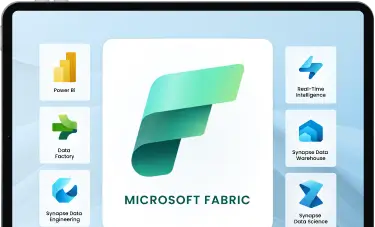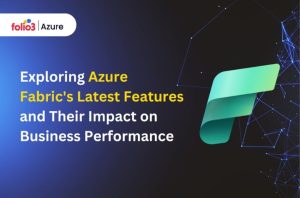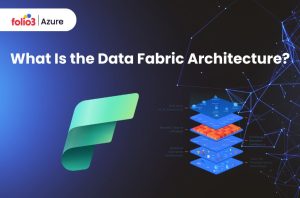Table of Contents
ToggleToday, our world revolves around data, a rapidly growing economy, and highly competitive businesses. Businesses face fierce challenges in managing and processing large-scale data. Data gathering from various channels and the need for real-time analytics and insights have made efficient data management the highest priority.
However, handling this data takes a lot of work. Conventional data management needs more scalability, speed, and integration capabilities. This is where Microsoft Fabric becomes highly useful by equipping businesses with a robust solution for managing large-scale data effectively.
Microsoft Fabric is an all-encompassing platform designed to handle the intricacies of present-day data environments. Whether handling voluminous datasets, integrating multiple data sources, or using advanced analytics, Microsoft Fabric provides all the tools required for success. Its features extend beyond simple data storage and processing. Instead, it comes with a suite of services that ensure your data is accessible, secure, and ready for analysis.
Accelerate smart decisions with Microsoft Fabric's unified data and AI analytics.

Strategies for Large-Scale Data Management with Microsoft Fabric
Here are the strategies for managing large data sets with Microsoft Fabric:
1. Data Integration
Efficient data management begins with smooth data integration. Microsoft Fabric is a pioneer in integrating diverse data sources, creating a unified data environment that simplifies data handling and analysis.
By gathering data from various systems, businesses can get a complete view of their operations, leading to intelligent decision-making. Microsoft Fabric’s integration capabilities are designed to handle structured and unstructured data, making it a flexible tool for modern enterprises dealing with various data types.
Moreover, Microsoft Fabric helps in creating a unified data environment. This environment centralizes data and ensures it is easily accessible to all stakeholders. By breaking down data silos, Microsoft Fabric supports collaborative and intelligent decision-making.
This high level of integration is necessary for businesses that must swiftly adapt to shifting market requirements and customer demands.
2. Automated Data Processing
Automation is the basis of Microsoft Fabric’s data management strategy. The platform utilizes automated data processing to boost efficiency and accuracy. Microsoft Fabric eliminates human error and speeds up data workflows by automating monotonous tasks such as data cleansing, transformation, and loading.
This is highly beneficial for managing large-scale data, where manual processing is time-consuming and prone to mistakes. With Microsoft Fabric, businesses can simplify their data operations, freeing resources for more important tasks.
Adding on, automated data processing in Microsoft Fabric is highly customizable. Businesses can personalize the automation to meet their needs, ensuring that their data processing meets their unique requirements.
This high level of customization is mandatory for organizations that need to process large volumes of data quickly and accurately without compromising quality.
3. Real-Time Data Streaming
In the intense business environment, processing data in real time is a significant advantage. Microsoft Fabric aids real-time data streaming, enabling organizations to process and analyze data as it enters their system.
This capability is highly needed for businesses that require the latest information to make critical decisions. Using real-time streaming, Microsoft Fabric ensures that data is processed with minimal latency, providing businesses with immediate information that can foster agile decision-making.
Real-time data streaming is also vital to enable machine learning in Microsoft Fabric. By providing real-time data into machine learning models, businesses can generate predictive insights that upgrade everything from inventory management to customer engagement tactics.
This real-time capability is precious in industries requiring timely decision-making, such as finance, healthcare, and e-commerce.
Optimizing Data Workflows
Data workflows are the arteries through which data flows. Optimizing them is essential to achieve flawless data management and processing.
Workflow Design
Designing flawless data workflows is vital for maximizing data throughput and minimizing latency. Microsoft Fabric provides all the tools to create optimized workflows to ensure data moves smoothly through the processing workflow.
Businesses can enhance their data processing capabilities by meticulously designing these workflows, ensuring that large-scale data is handled efficiently. Microsoft Fabric’s workflow management features enable a high level of customization, facilitating organizations’ personalization of their data workflows to meet specific business needs and operational targets.
Effective workflow design also includes considering cloud cost optimization. Data volumes soar in direct proportion to the costs associated with storing and processing them in the cloud.
Microsoft Fabric is embedded with tools that empower businesses to monitor and manage their cloud costs, ensuring they get the most value from their investments. Companies can balance speed, scalability, and financial efficiency by maximizing workflows for both performance and cost.
Customization and Scalability
One of Microsoft Fabric’s primary advantages is its ability to scale with your business. As data volumes grow, the platform’s high scalability lets you continue to manage and process data without compromising performance.
Microsoft Fabric enables high customization, enabling businesses to modify the platform according to their needs. Whether configuring data partitions, modifying processing workflows, or integrating new data sources, Microsoft Fabric has the flexibility to tackle the shifting demands of large-scale data management.
Scalability is more than just handling data. It also comprises maintaining performance as your data demands enhance. Microsoft Fabric is designed to scale horizontally and vertically, empowering you to add more processing power or storage capacity.
This is how your data management infrastructure can expand with your business without the need for costly and time-consuming revamps.
Security and Compliance in Data Management
Data security is prime whenever data handling is involved. Let’s examine how Microsoft Fabric guarantees robust data security for sensitive data.
Data Security Features
Microsoft Fabric addresses data security concerns with solid security features designed to protect sensitive information. The platform includes advanced encryption methods, access controls, and monitoring tools that help protect data at rest and while being transmitted.
These security measures are necessary for businesses that tackle large amounts of data, especially in industries where data breaches can have serious consequences. With Microsoft Fabric, companies can confidently manage their data, knowing that the latest security technologies protect it.
In addition to standard security features, Microsoft Fabric is embedded with advanced threat detection and response features. These modules allow businesses to proactively monitor their data environments for possible security threats and take swift action to reduce risks.
This level of protection is significant for organizations that handle sensitive customer data or function in industries where data security is a top priority.
Compliance Management
Along with security, compliance with industry regulations is a fundamental element of data management. Microsoft Fabric provides comprehensive compliance management features that help businesses meet regulatory requirements.
Microsoft Fabric provides tools for tracking and auditing data access and usage, guaranteeing that all activities comply with laws. This is important for organizations functioning in highly regulated industries, where failure to comply with data management regulations can result in fines and reputational damage.
Microsoft Fabric’s compliance management tools are highly flexible, supporting businesses in altering their compliance tactics as regulations change. Whether dealing with GDPR, HIPAA, or other industry-specific regulations, Microsoft Fabric provides the tools to ensure that your data management practices are compliant.
This flexibility is critical for businesses operating across multiple jurisdictions, each with its regulatory requirements.
Conclusion
To conclude Microsoft Fabric provides a powerful and all-encompassing solution for managing and processing large-scale data. Its strong features, including data partitioning, real-time analytics, and machine learning integration, make it a must-have tool for businesses seeking to remodel their data management strategies.
While there are certain challenges of customization and compliance, the benefits of implementing Microsoft Fabric far outweigh the difficulties.
By implementing Microsoft Fabric, businesses can manage their data more effectively and gain insights that foster better decision-making and improve performance. Whether you’re just starting with large-scale data management or aim to upgrade your existing infrastructure, Microsoft Fabric provides the tools and flexibility you need to succeed.
With careful planning, a focus on customization, and utilizing the platform’s maximum features, your organization can use the power of Microsoft Fabric to transform how you handle large-scale data, ensuring that your data management processes are both efficient and future-proof.
Discover how we can assist you in achieving successful Microsoft Fabric data management for your company’s success by exploring our top-notch Microsoft Fabric services at Azure.folio3.


